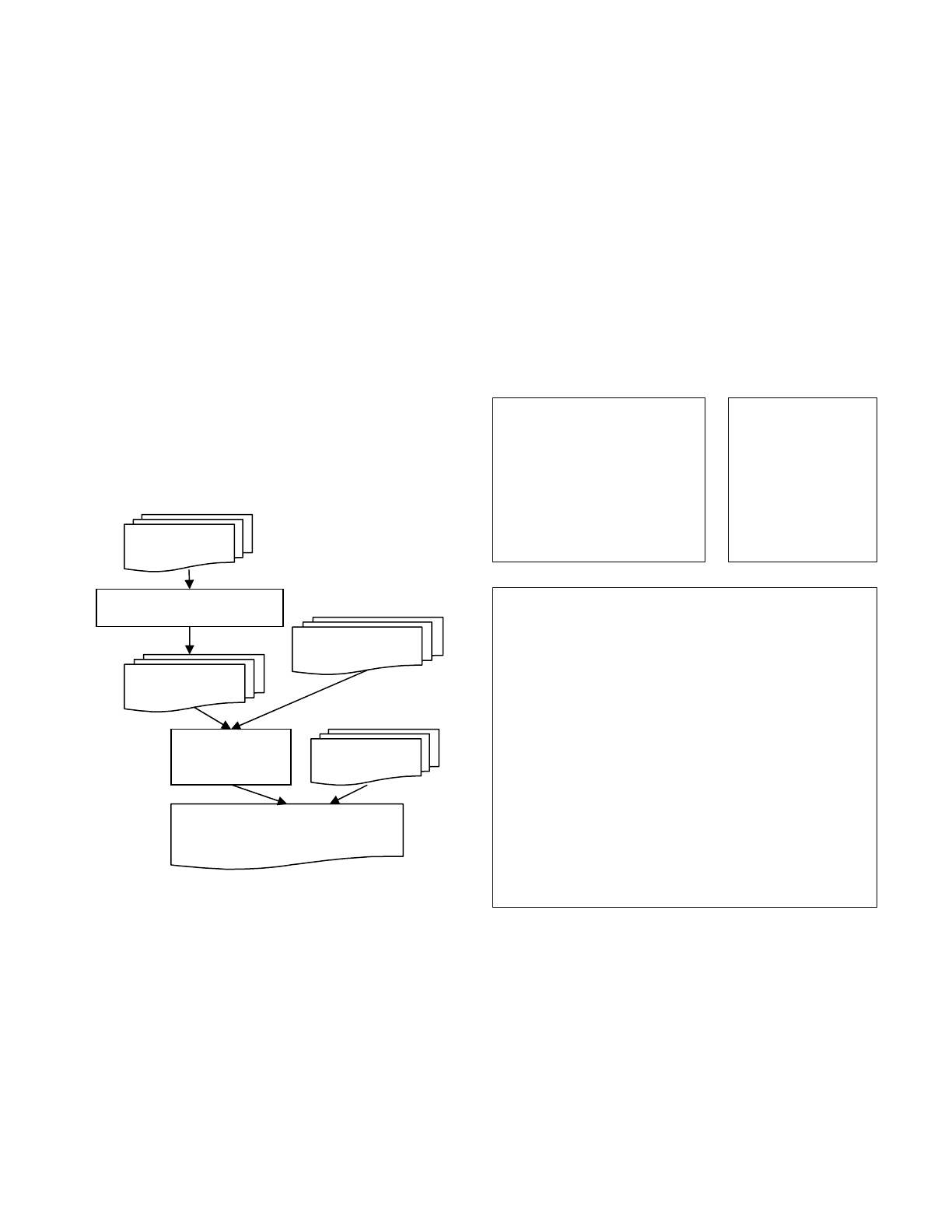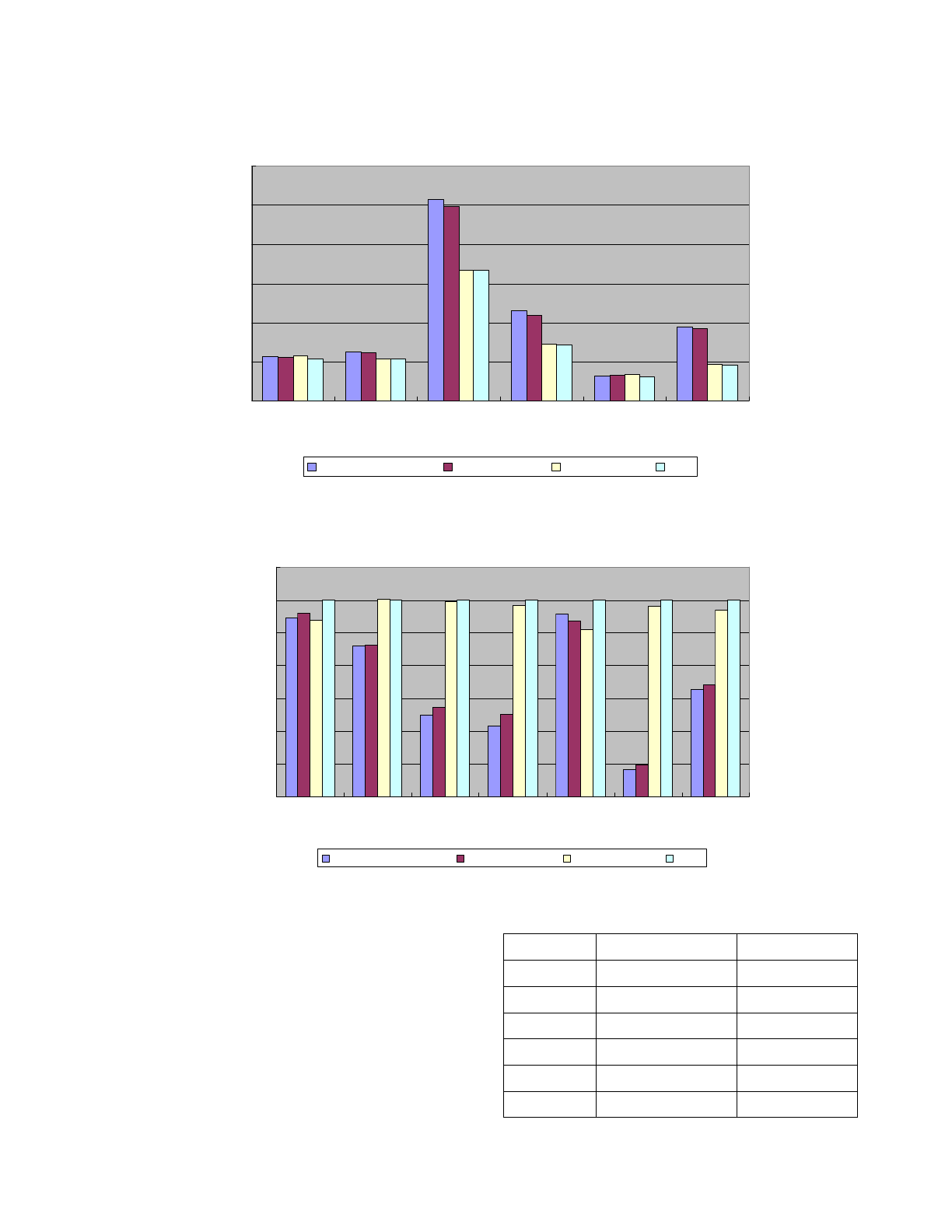
Efficient Exception Handling in Java Bytecode-to-C
Ahead-of-Time Compiler for Embedded Systems
Dong-Heon
Jung
JongKuk
Park
Sung-Hwan
Bae
Jaemok Lee
Soo-Mook
Moon
School of Electrical Engineering and Computer Science
Seoul National University, Seoul 151-742, Korea
{clamp, uhehe99, seasoul, jaemok, smoon}@altair.snu.ac.kr
Abstract
One of the most promising approaches to Java acceleration in
embedded systems is a bytecode-to-C ahead-of-time compiler
(AOTC). It improves the performance of a Java virtual machine
(JVM) by translating bytecode into C code, which is then
compiled into machine code via an existing C compiler. One
important design issue in AOTC is efficient exception handling.
Since the excepting point and the exception handler may locate in
different methods on a call stack, control transfer between them
should be streamlined, while an exception would be an
“exceptional” event, so it should not slow down normal execution
paths. Previous AOTCs often employed stack cutting based on a
setjmp()/longjmp(), which we found is involved with too much
overheads. This paper proposes a simpler solution based on an
exception check after each method call, merged with garbage
collection check for reducing its overhead. Our evaluation results
on SPECjvm98 on Sun’s CVM indicate that our technique can
improve the performance of stack cutting by more than 25 %.
Categories and Subject Descriptors
D3.3 [Programming Languages]: Language Constructs and
Features; D.3.4 [Processors]: Compilers, Run-time environments;
D.4.7 [Operating Systems]: Organization and Design-real-time
and embedded systems;
General Terms
Design, Experimentation, Performance, Languages
Keywords
Bytecode-to-C, Java ahead-of-time compiler, exception handling,
stack cutting, Java virtual machine, J2ME CDC
1. Introduction
Many embedded systems including mobile phones, digital
TVs, and telematics have employed Java as a standard software
platform, due to its support for platform independence, security,
and faster development of reliable software contents [1].
Platform independence is achieved by installing the Java virtual
machine (JVM) on each platform, which executes Java’s
compiled executable called bytecode via interpretation [2]. Since
this software execution is much slower than hardware execution,
compilation techniques that translates the bytecode into machine
code has been employed, such as just-in-time compiler (JITC)
[3] and ahead-of-time compiler (AOTC) [4-12]. JITC and AOTC
perform the translation during runtime and before runtime,
respectively. For embedded systems, AOTC is more useful since
it does not need runtime translation and memory overheads of
JITC, which is likely to waste the limited computing power and
memory space of embedded systems.
There are two approaches to AOTC. One is translating
bytecode directly into machine code [7-11], and the other is
translating bytecode into C code first, which is then compiled
into machine code by an existing compiler [4-6]. The
bytecode-to-C (b-to-C) approach is more practical since it allows
faster time-to-market by resorting to full optimizations of an
existing compiler and by using its debugging and profiling tools.
It also allows a portable AOTC.
One of the important issues in designing a b-to-C AOTC is
exception handling.[20] The Java programming language
provides try blocks and catch blocks such that if an exception
occurs in a try block, it is supposed to be caught by an
appropriate catch block depending on the type of the exception.
The problem is that the excepting try block and the
exception-handling catch block might be located in different
methods on the call stack, so if there is no catch block that can
handle the exception in the excepting method, the methods in the
call stack should be searched backward to find one that has an
exception-handling catch block [2].
Existing b-to-C AOTCs [4-5] employ a technique called stack
cutting [14-15] based on C’s library setjmp()/longjmp() pairs such
that a setjmp() is executed in the method that has a catch block
while a longjmp() is executed at the excepting method, which
allows direct control transfer from an excepting try block to an
exception-handling catch block. Unfortunately, we found from
experiments that stack cutting is inefficient since it affects the
performance for normal execution.
This paper proposes a different approach to exception handling
where we check if exception occurred whenever a method returns
in order to transfer control to an appropriate catch block. This is
inspired by JNI’s exception handling mechanism but with
additional improvements. We evaluated the proposed technique on
______________________________________________________________________
This research was supported in part by Samsung Electronics.
Permission to make digital or hard copies of all or part of this work for
personal or classroom use is granted without fee provided that copies are
not made or distributed for profit or commercial advantage and that
copies bear this notice and the full citation on the first page. To copy
otherwise, or republish, to post on servers or to redistribute to lists,
requires prior specific permission and/or a fee.
EMSOFT'06, October 22–25, 2006, Seoul, Korea.
Copyright 2006 ACM 1-59593-542-8/06/0010...$5.00.
188

a CVM in Sun’s J2ME CDC [12] environment where we
developed a b-to-C AOTC. We implemented both approaches and
performed experiments.
The rest of this paper is organized as follows. Section 2 briefly
overviews the JVM machine model and our b-to-C AOTC. Section
3 describes the stack cutting technique of previous b-to-C AOTCs.
Section 4 introduces our proposed technique based on exception
checks. Section 5 describes our experimental results. A summary
follows in Section 6.
2. Overview of Our Bytecode-to-C AOTC and
JVM
The structure of b-to-C AOTC which works with Sun’s CVM is
depicted in Figure 1. The AOTC translates bytecode into C code,
which is then compiled with the CVM source code using a GNU C
compiler [13]. Our AOTC selectively translates methods in class
files using a profile feedback in order to reduce the code size. This
is fine since our AOTC can work with the interpreter, so AOTC
methods and interpreter methods can run concurrently. This is
useful for an environment where we also need to download class
files dynamically (e.g., in digital TVs the Java middleware is
AOTCed while the xlets downloaded thru the cable line is
executed by the interpreter).
Figure 1. The Structure of our AOTC process
The Java VM is a typed stack machine [2]. All computations are
performed on the operand stack and temporary results are saved in
local variables, so there are many pushes and pops between the
local variables and the operand stack.
Each thread of execution has its own Java stack where a new
activation record is pushed when a method is invoked and is
popped when it returns. An activation record includes state
information, local variables and the operand stack. Method
parameters are also local variables which are initialized to the
actual parameters by the JVM.
Our b-to-C AOTC first analyze the bytecode and decides the C
variables that need to be declared. Each local variable and each
stack slot is translated into a C variable (which is called a local C
variable and a stack C variable, respectively). Since the same stack
slot can be pushed with differently-typed value during execution, a
type name is attached into a stack C variable name such that a
stack slot can be translated into multiple C variables. For example,
s0_ref is a C variable corresponding to a reference-type stack slot
0, while s0_int is a C variable corresponding to an integer-type
stack slot 0.
It then translates each bytecode one-by-one into
corresponding C statements, with the status of the operand stack
being kept track of. For example, iload_1 which pushes an
integer-type local variable 1 onto the stack is translated into a C
statement s0_int = l1_int if the current stack pointer points to the
zero-th slot when this bytecode is translated. Figure 2 shows an
example.
(a) Java Method
(b) Bytecode
public int max(int a, int
b) {
return (a>=b)? a:b;
}
0: iload_0
1: iload_1
2: if_icmplt 9
5: iload_0
6: goto 10
9: iload_1
10:ireturn
(c) Translated C Code
int Java_java_lang_Math_max_II(JNIEnv *env,
int l0_int, int l1_int)
{
int s0_int;
int s1_int;
s0_int = l0_int; // 0:
s1_int = l1_int; // 1:
if(s0_int < s1_int) goto L9 // 2:
s0_int = l0_int; // 5:
goto L10; // 6 :
L9: s0_int = l1_int; // 9:
L10: return s0_int; // 10:
}
Figure 2. An example of Java code and translated C code
Our AOTC method follows the JNI standard including its name.
The first argument of every function is CVMExecEnv *ee
which contains the interpreter stack, data structures for exception
handling and garbage collection, and so on. Other Java
arguments then follow. For synchronized method, additional C
code for locking the object is included right after variable
declaration.
Although we resort to C compiler’s optimization flags for
traditional optimizations, we also perform some Java-specific
optimizations such as method inlining, null check elimination,
array bound check elimination, class initialization check
Translated C
Existing
Class Bytecode
CVM Source Code
GNU C Compiler
Ahead-Of-Time Compiler
CVM Executable with
AOTC
Cl d I t
t
Downloaded
Class Bytecode
189

elimination, etc. since the C compiler is not aware that the
translated C code is from Java bytecode.
3. Stack Cutting based on setjmp()/longjmp()
The Java programming language provides an exception
handling mechanism for elegant error handling [2]. When an
error occurs during execution of code in a try block, the error is
caught and handled by an exception handler located in one of
subsequent catch blocks associated with it. If no catch block in
the method can handle the exception, the method is terminated
abnormally and the JVM searches backward through the call
stack to find a catch block which can handle the error. This
mechanism of searching the call stack is called stack
unwinding[14] in CVM.
Since an exception would be an “exceptional” event,
exception handling should be implemented in a way that normal
execution is affected as little as possible. Stack unwinding in the
interpreter mode of the CVM is certainly one such an
implementation. In a b-to-c AOTC, however, stack unwinding is
hard to implement since it is difficult in C to make a direct
control transfer from the excepting point to the exception
handler, if they are located in different methods on the call stack.
One possible solution is using setjmp()/longjmp() C libraries
[16,17].
The setjmp() function saves the current environment at a
jmpbuf-type object for later use by the longjmp(). The
longjmp() function with a jmpbuf-type object argument
restores the environment saved by the last call of setjmp() which
created the object. After the longjmp() completes, program
execution continues as if the corresponding call to setjmp() had
just returned [17]. This is perfect for implementing cross-method
jumps in C.
In fact, all previous b-to-C AOTCs employed a technique
called stack cutting using setjmp()/longjmp() functions. The idea
is that a setjmp() is executed at every method that has a catch
block, and the jmpbuf-type object created by the setjmp() is
pushed on a global stack of jmpbuf-type objects. Later, if a
method has an uncaught exception, a longjmp() is executed with
the top object of the global stack, which will transfer the control
to the method that created the top object. If the exception cannot
be handled in that method, the global stack is popped and a
longjmp() is executed again with a new top object. This process
repeats until the exception handler is found. In normal execution
when no exception occurs within the scope of a method where a
setjmp() is executed, the top object of the global stack is popped
before the function returns since the method cannot be a target of
a longjmp() any more.
There are other works to do for restoring the environment
when returned to the setjmp(). One is restoring the Java stack
frame of the returned method. The other is releasing locks from
all synchronized methods located between the longjmp() method
and the setjmp() method on the call stack. In order to implement
this, we need to maintain another global stack of locked objects
such that all synchronized methods are required to push their
locked object on the global stack at the beginning and pop it at
the end (even if there is no try block in the method). When
returned to the setjmp() of a synchronized method, we pop all
locked objects from the stack until this method’s locked object is
exposed. Then, we release all of popped objects’ locks.
After restoring the environment at the setjmp(), we need to
jump to an appropriate catch block. There have been two
approaches depending on where to place the setjmp(), especially
if there are multiple try blocks in a method. One is placing a
single setjmp() at the beginning of a method. The other is
placing a setjmp() at the beginning of each try block. The
setjmp()-per-method approach is advantageous if more than one
try block is executed in the method since the setjmp() will be
executed only once, whereas multiple setjmp()s will be executed
with the setjmp()-per-try approach (also the two global stacks
are pushed/popped at the beginning/end of each try block).
However, when returning from longjmp(), setjmp()-per-method
requires finding which try block caused the exception before
searching for the catch block associated with it. In order to help
this, we should save the bytecode PC before making a method
call within a try block, which will be used later to consult the
exception table for finding appropriate catch blocks to jump to.
For setjmp()-per-try, this is not necessary since we know which
catch blocks are associated with each try block. The
setjmp()-per-try will be advantageous if no try blocks are
executed in a method. Figure 3 depicts some part of simplified
pseudo code for stack cutting.
One more overhead of stack cutting is that for a method that
has a try block with a method call in it we need to keep all local
C variables in memory, not in registers, by declaring them
volatile. Since longjmp() restores register values as was when
setjmp() was executed, if a local variable is allocated to a
register and if it is changed after setjmp() is executed, longjmp()
will incorrectly restore its previous value. Stack C variables are
exempted from this requirement and can be allocated to registers
since they keep only temporary values and thus are not used
after setjmp().
The setjmp()-per-method approach was employed in [4,6],
while the setjmp()-per-try approach was employed in [5], but
there have been no evaluation of both techniques. In this paper,
we perform such an evaluation for them along with our proposed
technique. We implemented stack cutting as efficiently as
possible to make a fair comparison. For example,
z We place setjmp() and its related code in Figure 3 only
when there is a method call within a try block. If there is no
method call, there is no need for placing a setjmp().
z Instead of saving bytecode PC in setjmp()-per-method, we
save the label of the first catch block associated with a try
block such that when returned from longjmp(), we jump to
the first catch block directly instead of consulting with an
exception table (this works for gcc only). The catch block
will test the exception type and jump to the next one if not
matched.
z When there is an exception in a method and if it can be
handled there, the search process for the catch block is the
same as in our proposed technique which is based on
sequential search.
190

(a) At the method entry or at the try block entry
Push a new jmpbuf object on the global jmpbuf stack
Push “this” object on the global locked object stack
if( setjmp(jmpbuf) ) { // setjmp() return 0 initially, 1 when returned from longjmp()
If (synchronized method)
pop locked objects from the global stack upto “this” object and release their locks
Restore Java stack
s0_ref = global exception object
Find an appropriate exception handler
Jump to the exception handler;
(b) At the method exit or at the try block exit
Pop a jmpbuf object from the global jmpbuf stack
Pop an object from the global locked object stack
(c) When there is an exception that cannot be handle in the method
Make and save an exception object to global variable;
Longjmp ( the top jmpbuf object at the global jmpbuf stack, 1 );
Figure 3. Overhead of Stack Cutting on Normal Execution Paths
4. Proposed Exception Handling based on
Exception Checks
Stack cutting described in the previous section includes many
overheads for normal execution paths. The setjmp() library call
itself is a very costly operation. We should maintain global stacks
of jmpbuf objects and locks at the entry/exit of methods or try
blocks, even when there is no exception raised. Local C variables
for methods with try blocks should be kept in memory. Bytecode
PC should be saved at memory before making a call in
setjmp()-per-method.
In order to reduce these overheads for normal execution, we
propose a simpler solution based on exception checks. When an
exception occurs in a method but there is no catch block that can
handle it, the method simply returns to the caller. In the caller, we
check if an exception occurred in the callee and if so, try to find an
exception handler in the caller. If there is no exception handler, the
method also returns and this process repeats until an exception
handler is found. This means that we need to add an exception
check code after every method call, which would certainly be an
overhead, especially because its dynamic count will be much
higher than that of setjmp()s. However, it is a single comparison
while stack cutting includes substantial work to do.
In fact, we can reduce this overhead by merging the exception
check code with the garbage collection (GC) check code. CVM is
employing precise GC with a moving GC algorithm [18], which
can move objects during GC. If there is a GC in a callee method,
the caller method needs to restores all live reference-type C
variables from the Java stack frame because their reference values
(addresses) might be incorrect if their referenced object moved
during GC. So after every method call, there is GC check code.
Since GC would also be an “exceptional” event like an exception,
and since both should be checked after a method call, we can
merge both checks.
Our idea is declaring a global variable called
“global_gc_and_exception_count” which counts the
number of GCs or exceptions occurred during execution. There is
a local variable declared in each method called
“local_gc_and_exception_count”. At the beginning of a
method, local_gc_and_exception_count initialized by
global_gc_and_exception_count. After a method call,
we check if both variables are still the same. If not, we perform
appropriate actions depending on if GC or an exception occurred.
The point is that both variables will be the same most of the time,
which can obviate the overhead of a separate exception check.
Figure 4 depicts the merged GC and exception check code.
JNI also employs the exception checks for the callee, yet we
merged the exception checks with GC checks by using a global
variable, which makes the check overhead to zero cost.
When an exception occurs in a method and if there is a catch
block that can handle the exception in the same method, it should
obviously be handled there instead of returning to the caller. In
order to handle this case together with the
return-and-exception-check case, our exception handling proceeds
as follows. Each exception handler code is divided into two parts:
the check code to see if a given exception can be handled there
and the handler code itself. The AOTC analyze the bytecode to
figure out exception types that can possibly occur in a method and
exception types that can be handled in the method. If there is a
match, we make a direct jump to the corresponding handler code.
For other exceptions, we simply jump to the first exception check
code that can possibly handle them. If they cannot be handled
there, there is a jump to the next exception check code, and so on.
If the last exception check code cannot handle them, jump to the
method epilog where save the exception object in a global variable
and return to the caller. For stack cutting we implemented this case
in the same way.
191

Some_method_call();
If( local_gc_and_exception_count!=global_gc_and_exception_count ) {
local_gc_and_exception_count = global_gc_and_exception_count;
Restore all live local reference variables from Java stack frame;
AOTCExceptionOccurred(ee, exc);
If( exc != NULL ) {
s0_ref = exc;
Find and jump to the exception handler;
}
}
Figure 4. The check code after method call.
5. Experimental Results
Previous sections described stack cutting techniques based
on setjmp()/longjmp() and our proposed techniques based on
exception checks. Although exception checks would occur
much more frequently than execution of setjmp() during
normal execution, the individual overhead of setjmp() and its
related work to do would be higher than that of an exception
check. It would be worthwhile to evaluate these techniques
on the same environment.
5.1 Experimental Environment
We experimented with Sun’s CVM for which we
implemented a bytecode-to-C AOTC. On our AOTC we
implemented four cases of exception handling: two stack
cutting techniques, setjmp()-per-method and
setjmp()-per-try, and two exception check techniques,
merged check and separate check. We experimented with
these four cases.
The experiments were performed on an Intel Pentium4
2.40 GHz CPU with 512M RAM and the OS is Debian Linux
with kernel 2.6.8-2. The translated C code is compiled by
GNU C compiler (GCC) version 3.3.5. The CVM is
constrained to have 32M memory. The benchmarks we used
are SPECjvm98 (except for mpegaudio for which CVM
cannot read its class files).
5.2 Performance Comparison
We first measured how many exceptions occur in the
benchmarks. Table 1 shows the number of exceptions raised
and the average number of call depth differences between
the excepting method and exception handling method[19].
It shows that exceptions indeed occur rarely except for
javac and jack (all exceptions in others are
UnsupportedEncodingException, which occur due to the
character encoding in our Linux machine but does not affect
the execution results). And the call depth difference is short,
so the processing overhead for raised exceptions would be
small.
Table. 1 Exception behavior of SPECjvm 98 in CVM
Benchmarks Exception Count Call Depth
Difference
compress 7 2.0
Jess 10 2.0
Db 10 2.0
Javac 22408 1.9
Mtrt 7 2.0
Jack 241934 2.5
We first compare the running time of those four cases,
which is depicted in Figure 5. The graph shows that
exception checks are generally better than stack cutting,
especially for javac, db, jess and jack. For stack cutting,
setjmp()-per-try is a little better than setjmp()-per-method.
For exception checks, merged exception check is slightly
better than separate exception check. Figure 6 shows the
performance percentage compared to merged exception
checks.
In order to evaluate the overhead of stack cutting for
normal execution paths, we performed another experiment
where we added the overhead code of the
setjmp()-per-method or the setjmp()-per-try in Figure 3 (a)
and (b) to our merged exception check code so that setjmp()
code is executed additionally for normal execution paths.
Since exceptions will be handled by our exception check
code, this will just simulate what stack cutting does for
normal paths. We found that the running time difference
between this simulation code and our original exception
check code is the same as the difference between stack
cutting and merged exception check in Figure 5. This means
that the overhead code of stack cutting is the reason for its
longer running time in Figure 5 and the actual exceptions
raised do not affect the running time seriously.
192

Runnin
g
Time
0
10
20
30
40
50
60
Compress Jess Db Jav ac Mt rt Jack
Benchmark
Se
c
set
j
m
p()
-
p
er- method set
j
m
p()
-
p
er- tr
y
se
p
arate check ours
Figure 5. Running time for each case (seconds).
Performanc e
40.000
50.000
60.000
70.000
80.000
90.000
100.000
110.000
Compress Jess Db Javac Mtrt Jack Geoman
Benchmark
Performanc
e
set
j
m
p()
-
p
er- method set
j
m
p()
-
p
er- tr
y
se
p
arate check ours
Figure 6. Performance compared to merged exception checks
We also measured the dynamic numbers of setjmps() in stack
cutting cases, which are shown in Table 2. We also measured the
dynamic numbers of exception checks in Table 3. Generally, the
ratio of setjmp() frequency to exception check frequency is
higher for those benchmarks where stack cutting is slower than
exception checks in Figure 5. This also indicates that the
overhead caused by setjmps() and its related code in Figure 3 (a)
and (b) would be the reason for the performance loss. There does
not appear to be a direct relationship between the setjmp()
frequency and the performance between setjmp()-per-method
and setjmp()-per-try, though, probably due to insufficient
difference of frequencies to make a correlation.
Table 2. Dynamic Counts of setjmp() (thousands)
Benchmarks setjmp()-per-method setjmp()-per-try
compress 3.1 20
jess 35 67
db 158 93
javac 1,615 62
mtrt 32 270
jack 4,365 35
193

Table 3. Dynamic Counts of Exception Checks (millions)
Benchmarks merged checks
compress 20
jess 67
db 93
javac 62
mtrt 270
jack 35
6. Summary
A bytecode-to-C AOTC is one of the most promising approaches
to embedded Java acceleration but exception handling should be
implemented efficiently in order not to affect performance,
especially in normal execution since exception would be a rare
event. Stack cutting based on setjmp()/longjmp() includes too
much overhead for normal execution paths. We proposed a
simpler technique based on an exception check after every method
call. We found this is more efficient than stack cutting, especially
when the exception check is merged with the GC check in the
CVM, which leads to 25% better performance than stack cutting.
References
[1] Sun Microsystems, White Paper “CDC: An Application
Framework for Personal Mobile Devices”
[2] J. Gosling, B. Joy, and G. Steele, The Java Language
Specification Reading, Addison-Wesley, 1996.
[3] J. Aycock. "A Brief History of Just-in-Time", ACM
Computing Surveys, 35(2), Jun 2003
[4] T. A. Proebsting, G. Townsend, P. Bridges, J. H. Hartman, T.
Newsham, and S. A. Watterson, "Toba: Java for Applications
A Way Ahead of Time (WAT) Compiler," Proceedings of the
Third USENIX Conference on Object-Oriented Technologies
and Systems, Portland, Oregon, 1997
[5] G. Muller, B. Moura, F. Bellard and C. Consel, “Harissa: a
Flexible and Efficient Java Environment Mixing Bytecode and
Compiled Code”, In Proceedings of the 3rd Conference on
Object-Oriented Technologies and Systems pages 1-20,
Berkeley, June 16-20 1997.
[6] A. Varma, "A Retargetable Optimizing Java-to-C Compiler for
Embedded Systems," MS thesis, University of Maryland,
College Park, 2003
[7] M. Weiss, F. de Ferriere, B. Delsart, C. Fabre, F. Hirsch, E.
Andrew Johnson, V. Joloboff, F. Roy, F. Siebert, and X.
Spengler, “TurboJ, a Java Bytecode-to-Native Compiler”,
1998.
[8] M. Serrano, R. Bordawekar, S. Midkiff and M. Gupta,
Quicksilver: A Quasi-Static Compiler for Java, In Proceedings
of the ACM 2000 Conference on Object-Oriented
Programming, Systems, Languages and Applications
(OOPSLA’00). Pages 66-82, 2000.
[9] V. Mikheev, N. Lipsky, D. Gurchenkov, P. Pavlov, V.
Sukharev, A. Markov, S. Kuksenko, S. Fedoseev, D. Leskov, A.
Yeryomin, “Overview of Excelsior JET, a High Performance
Alternative to Java Virtual Machines”, in Proceeding of the
third international workshop on Software and performance
WOSP’02, ACM Press. 2002.
[10] R. Fitzgerald, T. B. Knolock, E. Ruf, B. Steensgaard, and D.
Tarditi, “Marmot: An Optimizing Compiler for Java”,
Microsoft Technical Report 3. Microsoft Research, March
2000.
[11] Instantiations, Inc. JOVE: Super Optimizing Deployment
Environment for Java, http://www.instantiations.com., July
1998
[13] Sun Microsystems, CDC CVM,
http://java.sun.com/products/cdc
[13] GNU, Gnu Compiler Collection, http://gcc.gnu.org.
[14] T. Ogasawara, H. Komatsu and T. Nakatani, “A Study of
Exception Handling and Its Dynamic Optimization in Java”, In
Proceedings of ACM SIGPLAN Conference on
Object-oriented Programming Systems, Languages and
Applications (OOPSLA’01), pages 83-95, 2001
[15] Ramsey, N., and Peyton Jones, S. “A single intermediate
language that supports multiple implementations of exceptions”.
Proceedings of the ACM SIGPLAN 20000 Conference on
Programming Language Design and Implementation (PLDI’00),
pages 285-298, May 2000.
[16] de Dinechin, C. C++ exception handling. IEEE Concurrency,
8(4), pp. 72-79, 2000.
[17] Cameron, D., Faust, P., Lenkov, D., And Mehta, M. A
portable implementation of C++ exception handling. In
Proceedings of the C++ conference, USENIX Association,
pp.225-243, Aug. 1992.
[18] Cohen, J., AND Nicolau, A. “Comparison of compacting
algorithms for garbage collection”. ACM Transactions on
Programming Languages and Systems 5(4), pp. 532-553,
October 1983.
[19] S. Lee, B. Yang, S. Moon, et al. “Efficient Java exception
handling in just-in-time compilation” In Proceedings of the
ACM 2000 Conference on Java Grande (New York, NY, USA,
June 2000), ACM Press, pp. 1-8
[20] J. Lang, D. B. Stewart, “A Study of the Applicability of
Existing Exception-Handling Techniques to Component-Based
Real-Time Software Technology” TOPLAS’98
194
